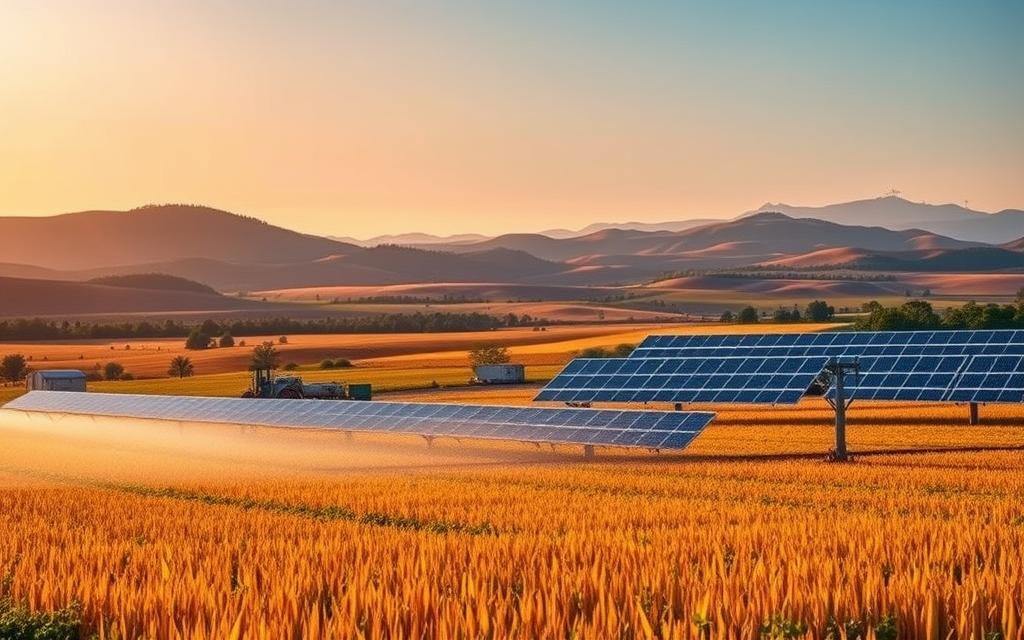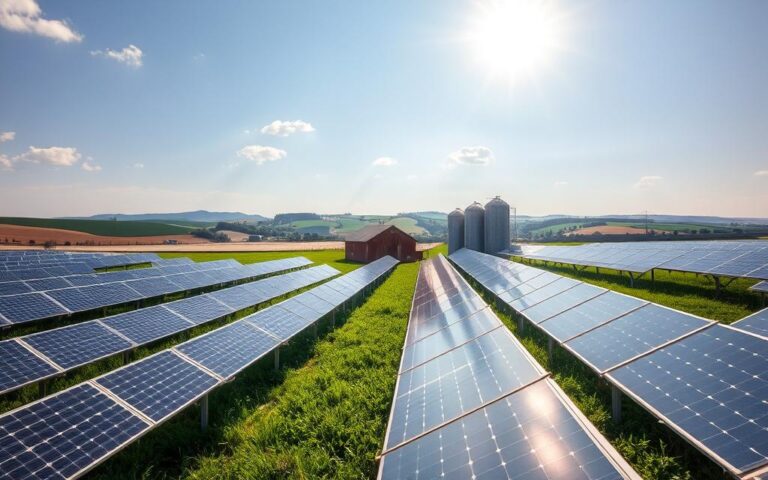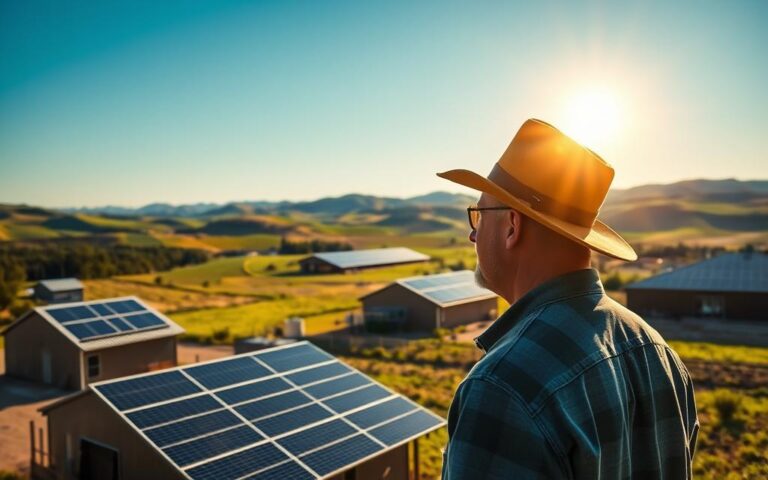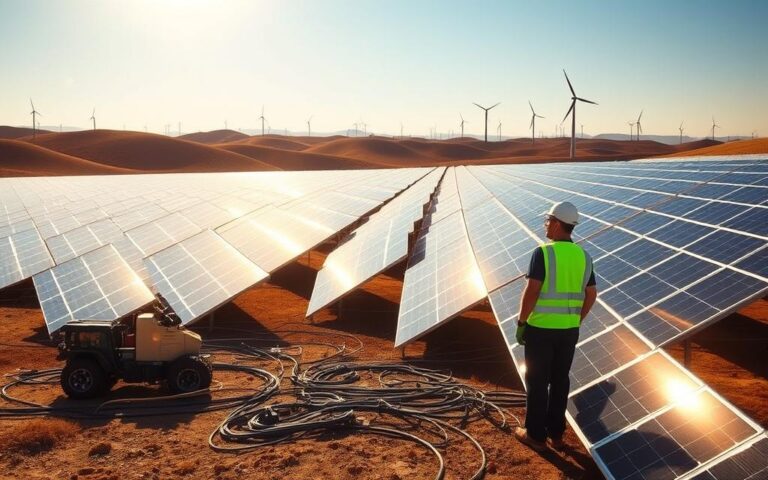Agriculture uses about 80% of the U.S.’s freshwater. Water scarcity is a big problem. Solar powered irrigation systems are changing the game for U.S. farmers. They use the sun’s power to save water and cut down on energy costs.
Solar irrigation systems in the USA turn sunlight into electricity. This electricity powers pumps that water crops directly. It’s a smart way to use water and cut down on fossil fuel use. It’s also good for the planet and helps farms stay profitable.
The Importance of Sustainable Farming Practices
Sustainable farming is key to solving environmental problems and using natural resources wisely. It’s about finding a balance between growing food and protecting nature. This way, it helps local economies and ensures food for everyone worldwide.
Understanding Sustainable Agriculture
Sustainable farming keeps ecosystems healthy while making farming work. It uses methods like crop rotation and organic farming. These methods boost productivity and help use resources better.
They also support biodiversity, making farms more resilient to climate changes.
Impact of Climate Change on Farming
Climate change changes weather patterns and makes extreme weather more common. This hurts crop yields and makes water scarcer. To tackle these issues, we need sustainable farming.
Using efficient irrigation is crucial. It helps use water well and cuts down on waste. This is especially important for farmers facing unpredictable weather.
The Necessity for Efficient Irrigation Solutions
Agriculture uses a lot of the world’s freshwater. We need better irrigation to save water. Solar-powered irrigation is a smart choice.
It uses water better and doesn’t rely on fossil fuels. This helps solve water problems and makes farming better for the planet.
What Are Solar-Powered Irrigation Systems?
Solar-powered irrigation systems use the sun’s energy to pump water for farms. They aim to make water more available and sustainable. This helps reduce costs and boosts farm productivity responsibly.
Definition and Functionality
Solar irrigation systems use solar panels to turn sunlight into energy for irrigation. Farmers can use this energy to power motors. These motors pull water from wells, rivers, and reservoirs.
This method makes water distribution efficient and cuts down on energy costs. It’s especially helpful in areas far from power sources.
Components of Solar-Powered Systems
Knowing the parts of solar irrigation systems helps them work better. The main parts are:
- Solar Panels: These panels catch sunlight and turn it into electricity.
- Motor Pumps: They pull water from sources and send it to fields.
- Pump Controllers: These control the pumps to use water and energy wisely.
These parts work together to improve farm output and protect the environment.
Advantages of Solar-Powered Irrigation Systems
Using solar-powered irrigation systems helps farmers a lot. It makes their work more efficient and green. This new tech makes farming cheaper and better for the planet.
Cost Savings in Operations
Using solar for irrigation cuts down on costs. Farmers save money on fuel and electricity. This saves them money over time.
They can use this saved money to grow more and work better. It’s a smart move for their farms.
Environmental Benefits
Solar irrigation is great for the environment. It uses clean energy, which cuts down on pollution. This helps keep the planet healthy and farms strong.
It’s good for the planet and helps farms last longer. This is a win-win for everyone.
Reducing Dependency on Fossil Fuels
Solar irrigation helps farmers use less fossil fuel. This makes farming more stable and green. It helps farmers stay strong against price changes.
By using solar, farmers help the planet and their farms. It’s a step towards a greener future.
| Advantage | Description |
|---|---|
| Cost Savings | Lower operational expenses due to reduced fuel and electricity reliance. |
| Environmental Benefits | Decreased carbon emissions and support for biodiversity through renewable energy usage. |
| Reduced Fossil Fuel Dependence | Enhancing sustainability and resilience against fuel price fluctuations. |
Types of Solar-Powered Irrigation Methods
There are many solar irrigation methods for farmers to choose from. Each one has its own benefits and can reduce the need for traditional energy. Knowing about these methods helps farmers use water better and grow more crops.
Surface Irrigation
Surface irrigation uses gravity to spread water over fields. It works well for crops like rice and wheat. Farmers use slopes to make sure water covers the whole field. It’s a simple and good choice for big, flat lands.
Localized Irrigation Techniques
Localized irrigation, like drip and trickle systems, sends water right to the roots. This saves water and gives the right amount to crops like fruits and veggies. It’s key for growing more with less water.
Sprinkler Irrigation Systems
Sprinkler systems spread water like rain, covering big areas. They work for many crops. Farmers can change when and how long to water, making it more effective.
Essential Components of Solar Irrigation Systems USA
Solar irrigation systems use key parts to deliver water efficiently. These parts work together well. They include solar panels, motor pumps, and pump controllers. Each part is important for the system’s success.
Solar Panels
Solar panels are at the center of these systems. They turn sunlight into electricity. This electricity powers the irrigation system.
By using the sun’s energy, farmers can save money on energy costs. High-efficiency solar panels ensure farmers can water their crops even when energy is scarce.
Motor Pumps
Motor pumps are vital for moving water from sources like wells or rivers. They come in surface and submersible types. This meets different irrigation needs.
The mix of solar power and pump design moves water well to crops. This boosts crop growth and farm productivity.
Pump Controllers
Pump controllers, like inverter controllers and VFDs, manage energy to pumps. They make the system work better and last longer. Good controllers help track water use.
This ensures water is used well and saved in solar irrigation systems.
Choosing the Right Solar Water Pump
Choosing the right solar water pump is key for good irrigation in farming. Many things affect this choice, like the water’s depth, how much water you need each day, and your current irrigation setup. Knowing these factors for selecting pumps helps pick the best one for your farm.
Factors to Consider
- Depth of Water Source: Knowing how deep the water is is crucial for picking the right pump.
- Water Demand: Figuring out how much water you need daily helps decide the pump’s size and how well it works.
- Irrigation Type: It’s important to know if you need a surface or submersible pump, depending on your irrigation method.
Matching Pump Types with Needs
After deciding on choosing solar water pumps, you need to match the pump type with your farm’s needs. Surface pumps are good for shallow water, while submersible pumps are better for deeper wells. Picking the right pump means your farm will run smoothly and crops will grow well.

| Pump Type | Best For | Advantages |
|---|---|---|
| Surface Pump | Shallow Water Sources | Cost-effective, easier to maintain |
| Submersible Pump | Deep Wells | Higher efficiency, better for greater depths |
The Growing Adoption of Solar Irrigation Technology
Farmers worldwide are turning to solar irrigation as a green alternative. This shift is driven by rising energy costs and environmental concerns. Countries are making strides in solar irrigation, each facing its own set of challenges.
Global Trends in Solar-Powered Irrigation
Studies show a rise in solar irrigation in places like India and Australia. Government support has been key in these countries. Solar irrigation has boosted efficiency and cut costs for farmers.
Farmers see better yields and use less fossil fuel. This shows that green farming can be cost-effective.
Challenges Facing Adoption in the U.S.
In the U.S., solar irrigation faces big hurdles. The high upfront costs scare off many farmers. There’s also a lack of knowledge about solar tech in farming circles.
These issues block the adoption of solar irrigation. They slow down the growth of sustainable farming in the U.S.
Innovations in Solar-Powered Irrigation
New advancements in solar irrigation systems are changing the game. Innovations in solar irrigation include automation and smart technologies. These features help farmers use water more efficiently, leading to better crop yields.
Automation and Smart Technologies
Smart irrigation technologies use data to help farmers use water wisely. Farmers can control their systems from their phones. This lets them check and adjust things in real-time, without being there.
Features like scheduling and checking soil moisture levels make things more efficient. This is a big win for farmers.
Future Developments in Solar Irrigation
The future of solar irrigation looks promising. Soon, automated water level sensors will help farmers give their crops just the right amount of water.
Also, better battery storage will let farmers use solar energy even when it’s dark. This is a big step towards making farming more productive and sustainable.
| Innovation | Description | Benefits |
|---|---|---|
| Remote Monitoring | Control irrigation systems via mobile devices | Greater flexibility and efficiency |
| Automated Sensors | Use of sensors to monitor soil moisture | Optimized water application |
| Battery Storage | Store excess solar energy for after-hours use | Increased usability and reliability |

Benefits of Solar Water Pumping Systems for Agriculture
Solar water pumping systems bring many benefits to farming. They help farmers use water more efficiently and sustainably. This leads to better farming practices and growth.
Increased Productivity
Using solar water pumping systems can make farming more productive. Farmers get the water they need to keep soil moist. This helps crops grow better and faster, leading to more harvests each year.
Reliability in Water Supply
Having a reliable water supply is key for farming. Solar water pumping systems provide a steady water flow. This reduces the risk of crop loss due to drought and helps crops grow well.
Economic Impact on Farming
The economic impact of solar irrigation is big for farmers. Solar tech saves money on energy, upkeep, and labor. These savings help farmers make more money and support their communities.
| Benefit | Description |
|---|---|
| Increased Agricultural Productivity | Higher crop yields and improved quality through consistent irrigation. |
| Reliability in Water Supply | Steady access to water minimizes losses due to drought. |
| Economic Impact | Reduced operational costs lead to greater profitability and community support. |
Conclusion
Solar-powered irrigation systems are changing farming in the United States. They use renewable energy to solve problems like water scarcity and high energy costs. This helps protect our environment too.
The need for more food is growing fast. Solar irrigation systems are key to meeting this need. They help farmers work better and make farming more sustainable.
Using solar irrigation will change how we farm. It will make farming both profitable and good for the planet. This move is crucial for a sustainable future in agriculture.




